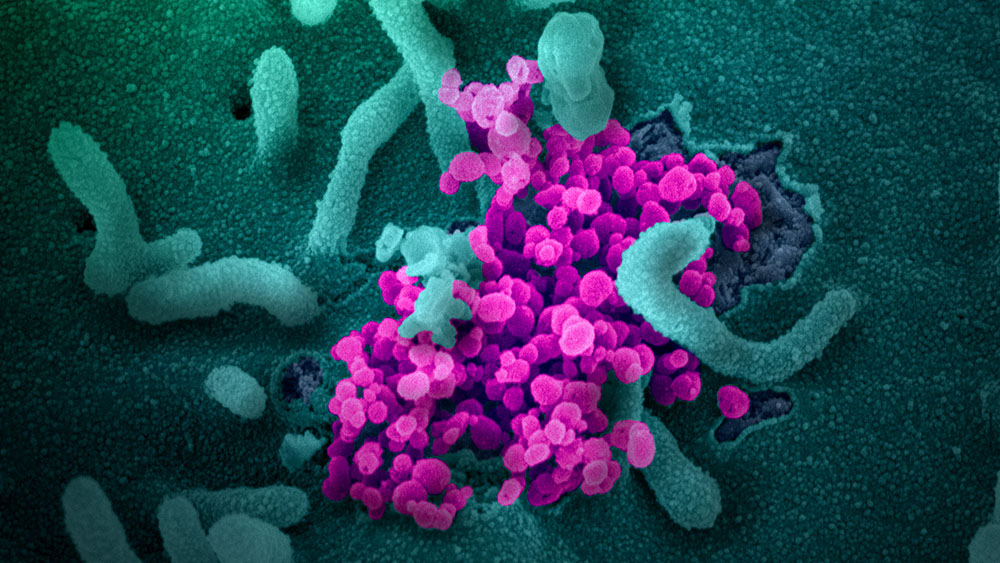
A scanning electron microscope image of SARS-CoV-2 (in magenta) emerging from the surface of human cells grown in a lab. Each infected cell can release up to 100 new viruses. Every time the virus multiplies in a cell, mutations are possible.

A scanning electron microscope image of SARS-CoV-2 (in magenta) emerging from the surface of human cells grown in a lab. Each infected cell can release up to 100 new viruses. Every time the virus multiplies in a cell, mutations are possible.
What you need to know
Variety is the spice of life — except when it comes to viral infections like COVID-19, which is caused by the SARS-CoV-2 virus. The more that SARS-CoV-2 spreads, the greater the chance that its genetic material will change, or mutate, creating new variants or strains. The virus builds up mutations as it passes from person to person, possibly becoming a variant of concern (VOC). VOCs may spread more quickly, cause more severe disease, or be resistant to treatments and vaccines.
The good news is that every person has the power to help stop VOCs by slowing the spread of SARS-CoV-2.
Variants taking over
VOCs pop up in one spot, spread rapidly, and eventually dominate in some areas. For example, VOC B.1.1.7 — otherwise known as the Alpha variant — first emerged in the United Kingdom in September 2020. As of June 2021, it has been found in 144 countries and is the most common variant circulating in the United States.
John Mascola, M.D., director of NIH’s Dale and Betty Bumpers Vaccine Research Center, has been keeping an eye on SARS-CoV-2 variants.
“We know that the virus mutates more rapidly than we expected. As the pandemic continues, there will be more variants,” Mascola said. “Vaccines are less effective against some viral variants, and some treatments may not work as well either.”
Examples of SARS-CoV-2 Variants of Concern
|
Variant name |
Where it was first found |
Characteristics |
|---|---|---|
|
B.1.1.529 (Omicron) |
South Africa |
|
Source: Centers for Disease Control and Prevention (CDC). Retrieved August 2, 2022 from https://www.cdc.gov/coronavirus/2019-ncov/variants/variant-classifications.html
Stop VOCs to stop the pandemic
It is important to get vaccinated and maintain COVID-19 safeguards, whether you have already been vaccinated or haven’t been vaccinated yet. Limiting the spread of SARS-CoV-2 gives it fewer chances to mutate.
Mascola noted that current vaccines still provide protection against VOCs and are especially effective at preventing serious disease and hospitalization.
“We need to get people vaccinated as fast as we can,” Mascola said. “We need to keep immunity at high levels, possibly by giving booster shots in the future. Most important, we need a global approach to fighting SARS-CoV-2 as it spreads and mutates.”
Where can I go to learn more?
The CDC shares up-to-date information about the Omicron variant of the SARS-CoV-2 virus.
COVID Data Tracker: Variant Proportions
The CDC is monitoring new and emerging SARS-CoV-2 variants to understand the implications for COVID-19 diagnostics, treatments, and vaccines.
Find a COVID-19 Vaccine Near You
Answers to common questions about COVID-19 vaccines and guidance on scheduling vaccine appointments.
Information on SARS-CoV-2 transmission and guidance on how to protect yourself against getting COVID-19.
Sources
Brookman, S., Cook, J., Zucherman, M., Broughton, S., Harman, K., & Gupta, A. (2021). Effect of the new SARS-CoV-2 variant B.1.1.7 on children and young people. The Lancet Child & Adolescent Health, 5(4), e9–e10. https://doi.org/10.1016/S2352-4642(21)00030-4
Centers for Disease Control and Prevention. (2021). COVID Data Tracker. Retrieved May 25, 2021, from https://covid.cdc.gov/covid-data-tracker/#variant-proportions
Davies, N. G., Abbott, S., Barnard, R. C., Jarvis, C. I., Kucharski, A. J., Munday, J. D., Pearson, C., Russell, T. W., Tully, D. C., Washburne, A. D., Wenseleers, T., Gimma, A., Waites, W., Wong, K., van Zandvoort, K., Silverman, J. D., CMMID COVID-19 Working Group, COVID-19 Genomics UK (COG-UK) Consortium, Diaz-Ordaz, K., Keogh, R., Edmunds, W. J. (2021). Estimated transmissibility and impact of SARS-CoV-2 lineage B.1.1.7 in England. Science (New York, N.Y.), 372(6538), eabg3055. https://doi.org/10.1126/science.abg3055
Mahase E. (2020). Covid-19: What have we learnt about the new variant in the UK? BMJ (Clinical Research Ed.), 371, m4944. https://doi.org/10.1136/bmj.m4944
Mascola, J. R., Graham, B. S., & Fauci, A. S. (2021). SARS-CoV-2 viral variants—Tackling a moving target. JAMA, 325(13), 1261–1262. https://jamanetwork.com/journals/jama/fullarticle/2776542
Sender, R., Bar-On, Y. M., Flamholz, A., Gleizer, S., Bernsthein, B., Phillips, R., & Milo, R. (2020). The total number and mass of SARS-CoV-2 virions. medRxiv: The Preprint Server for Health Sciences, 2020.11.16.20232009. https://doi.org/10.1101/2020.11.16.20232009
Wang, P., Nair, M. S., Liu, L., Iketani, S., Luo, Y., Guo, Y., Wang, M., Yu, J., Zhang, B., Kwong, P. D., Graham, B. S., Mascola, J. R., Chang, J. Y., Yin, M. T., Sobieszczyk, M., Kyratsous, C. A., Shapiro, L., Sheng, Z., Huang, Y., & Ho, D. D. (2021). Antibody resistance of SARS-CoV-2 variants B.1.351 and B.1.1.7. bioRxiv: The Preprint Server for Biology, 2021.01.25.428137. https://doi.org/10.1101/2021.01.25.428137

News and Stories
Read stories about the efforts underway to prevent, detect, and treat COVID-19 and its effects on our health.
 An official website of the United States government
An official website of the United States government

